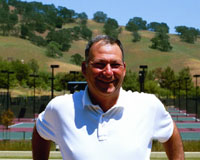Footwork:
Ready Position
By Michael Friedman, USPTA
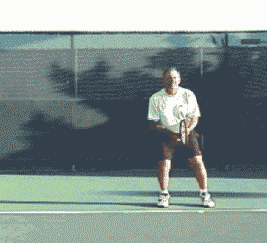 |
Start from a low ready position with a wide stance, learn when to split step,
stay low with knees bent when moving to the ball and when recovering. |
Ultimately the secret to great tennis is great footwork! Great footwork means the ability to move into position to hit the ball and then recover and be ready for the next shot. Great footwork will improve your reactions to the ball and how you well judge it. It will move you consistently into better position and improve your strokes. It will help you generate power from the ground and up through your body. Good footwork will provide the rhythm and timing of the point, and much, much more.
This may sound simple, but it takes work and discipline to develop. Tennis teachers teach the ready position in the first
lesson to beginners, but may not emphasize it enough with every level of play. I find myself coming back
to the ready position in almost every lesson. If students can make the first move correctly and get back
into the ready position, they can make the first move to the next shot the same way. That consistency
builds confidence.
The starting point for developing great footwork is the correct ready position. This is the a basic athletic position common to many sports with a low center of gravity and a wide stance.
There are physical, technical and mental elements to this ready position. This article focuses on the physical elements. You can read about the mental aspects in my first article in this series, entitled "Concentration". I'll address the technical elements in a later article as well.
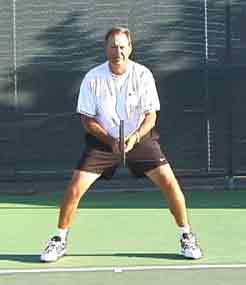 |
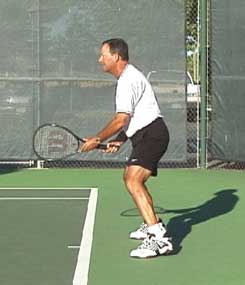 |
The starting point for developing great footwork is an athletic ready position
with low center of gravity and wide stance, shown above in front and side views |
|
Every ball you react to in tennis is slightly different from every other. By reacting out of the same ready position each time, making the same first move, you will develop muscle memory that will help you respond in the same fundamentally sound way to all different situations. And you can learn to do this automatically.
Players should begin getting ready, or establishing the ready position, when their opponent is hitting the ball. Most players tend to think about what they are doing only when they are hitting the ball themselves. In reality, you have to take the time to think about your ready position and challenge yourself to get back into it by the time your opponent is hitting the next shot.
Establishing the Ready Position
You can get into the ready position right now while you are reading this, and develop a feeling for the position. When you get on the court, stand one yard behind the baseline and do the same.
Widen your stance so that your feet are a little more than shoulder width apart. Now try to widen them a little more until you feel like they are too wide apart. This might be uncomfortable but it is probably correct. Feel like you are standing up straight. Your lower back is concave, that is, the small of your back is curved in towards your spine. Your shoulders are level and your head is facing forward. Now bend your knees and reach down with your fingertips and touch the top of your kneecaps, while keeping your back straight. Feel how your weight has transferred to the balls of your feet and your toes. There should be no weight on your heels. Don't lift your heels, just keep the weight off of them. When you look down you should see your knees covering your toes.
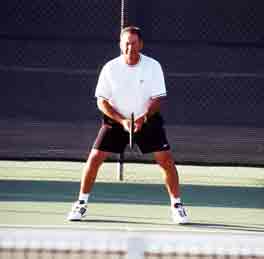 |
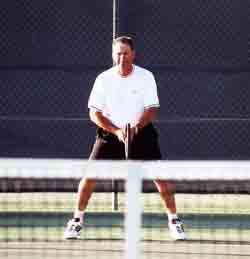 |
If you can see the intersection of the court and the back fence looking over the net,
your ready position is too high |
From the correct, low ready position, you are looking
through the net to see the intersection of the court and the back fence |
When you get to the court, establish this position and look up. You should be looking through the net to see where the court surface meets the back fence. If you are looking over the net to see this intersection, you're too high. Lower your position until you see the intersection of the court and the back fence through the net. This position should feel like you are guarding someone in basketball, or you're playing the linebacker position in football, or shortstop in baseball. This basic athletic position should be used in all ball sports.
Hold this low center of gravity position and move your feet in place for ten seconds like you are running as quickly as you can. Feel your quickness, agility and balance by keeping your feet apart and your knees bent. Experiment and see how quick and agile you are when you stand up straight with your feet together and again try to move your feet as quickly as you can again. You should be able to move your feet much faster when you are lower. When you bend your knees, widen your stance, and keep your back straight, you are creating leverage in your toes, feet, ankles, knees and hips.
Staying with this low center of gravity will allow you to move to the ball with your lower body while keeping your back or spine fairly vertical and straight. This will provide good balance and allow you to stroke the ball correctly, creating an elegant look! Knees bent and the back straight might remind you of Groucho Marks running around the court and that might be a good image for you to keep in mind if you can keep from laughing.
This position might sound simple but it is not easy! Keeping your knees bent means you are stressing your quadriceps, hamstrings, ankles, calves, and shins, plus your glutes, which together makeup the biggest muscle groups of your body. These muscles will demand a greater blood flow. You will definitely start to feel it in your heart rate and respiration. Try to stand in the correct ready position for a minute. You will feel it! This is a much more physically demanding position, and that might be why you would rather stand up straight with your knees locked and rest a little when your partner or opponent is hitting. But remember, while the ball is in play there is no time to rest. Stay down into the ready position and be prepared to time your split step. You can rest between points, but not between shots! If you start at this lower center of gravity with your knees bent, you will already be in a bent knee position for your strokes!
Your knees should always be bent and in your ready position, as you move to the ball, hit the ball, and recover back to the middle.
Watch closely next time you are at a baseball game. Every time the ball crosses the plate the entire infield does the split step? This alerts the infielder to be ready to move in any direction when the ball comes off the batter's bat. The same is true every time your opponent hits the ball. You are on defense, ready to react. The split step is timed so that your feet are separating three to four inches more than when you started. Your feet should touch down just as your opponent hits the ball. Time your split with his hit. Land low and on your toes, ready to shift your weight in the direction you see the ball coming off your opponent's racquet. This shift is also called the load.
You can see this best when watching tennis on television by looking at the pros' knees. See how the knee bends more toward the side the player is moving. Watch the returner getting ready for the serve. Great returners start with their feet far apart. They might start with their body bent forward from the waist, but just as the server gets ready to toss the ball they will stand up a little straighter but keep their feet apart. Then they split their feet apart even further, timed to the ball hitting the server's racquet.



